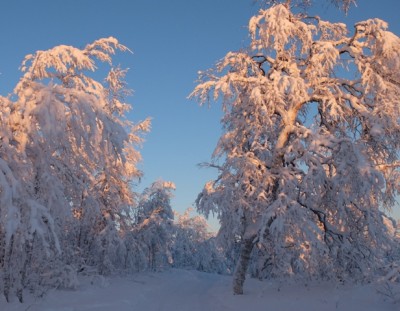I like to watch snow settle. How it falls, spreads itself in wide hanging swathes on the top of balconies, sprinkles itself over a wire fence, sweeps along the ground in giant waves, hangs precariously from rooftops, drapes itself elegantly along branches, and, later, how it covers every single twig in a sparkling muffle of white, pulling branches into gentle curving structures that sway in the wind. We watch the snow fall, but then we have to decide where to remove it.
When we first moved here I was so excited looking out over the garden covered in snow. Just think, all this snow is ours! Our neighbour thought me very foolish, knowing the reality.Yes, ours, meaning that when it’s in the way you are responsible for moving it. At first I only wanted to remove the bare minimum, not even wanting to pile the snow up if it disturbed the look of smooth, untouched areas I admired from the house. But I’ve learned over time – three long, hard winters have made me a realist.
My particular favourite has been snow on trees, and, blissfully, there has been no reason to remove this. It hangs over us, at worst threatening a shower of cold snow from time to time when the wind blows, but otherwise obstructing nothing. Snow-covered trees against a blue sky are a thing of beauty. Even in the darkness of winter the moonlight makes the trees shine.

Snow on trees is a kind of sakura, a blossom that celebrates life. Like people in Japan admire cherry blossom, I’m drawn to looking at trees with hanging snow. Although there is nothing of the spring in them, there is something of the gloriousness of living. It’s hard to celebrate this with hanami, picnicking underneath the trees in company, drinking sake, gazing up through the white billowing branches at the blue sky – though the idea, in theory, appeals.
Like the cherry blossom, snow blossom is short-lived, which is a part of its appeal. It isn’t long before the wind blows it all away, or the temperature rises enough to disturb its grip. It inspires you to enjoy it while you can.
Not always though. This year we returned to trees bending heavily with snow, more than we’d ever seen. Birch trees up here are tough, and their ability to flex and bend help them to survive, but it was clear that such an abundance of sakura was just too much for some of them. Everywhere you could see trees that had broken in half with the weight, or lost their tops, or if already leaning they had broken at the roots as the snow pulled them over.
This is what happened to the birch trees in the middle of our garden. I’d thought the angle of them rather jaunty and characterful before, but jauntiness led to their demise. Elsewhere around our house trees were leaning over in a way that was pretty to look at, but to the tree was life-threatening.
I admired the sakura for just one day, knowing it wouldn’t last. This time it was me that broke the spell. I stood underneath a birch tree and looked up through the snow blossoms into the blue sky – did I really have to do this? But I had already reasoned that releasing them from this icy grip was a humane decision.
I began to hit a tree with a broom. I felt the eyes of passers-by swivelling in my direction – it was suspicious behaviour, I could see that. But I cared less about that than I did about the feeling that I was using violence against a thing of beauty. A mass of cold snow fell down the back of my neck in revenge. But then I felt the tree released from its burden, the thin branches begin to bounce back up to the sky.
Flushed with success I moved on to the next bent-over beauty, and the next. The more I whacked the birch trees, and the more the snow cascaded down, the more I enjoyed it. More and more trees returned to the sky. There are certainly some weird and wonderful ways to entertain yourself in Kiruna in November. ‘Tree-whacking’ – could it be the next big thing after dog-sledding?

